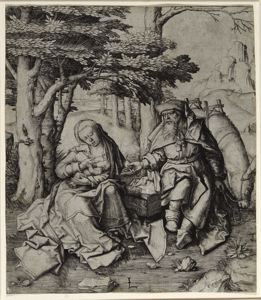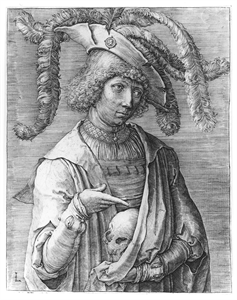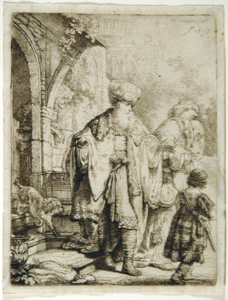
Lucas van Leyden (aka Lucan Van Leyden)
Dutch, about 1489/1494–1533
Lucas van Leyden’s engraving "Rest on the Flight into Egypt" depicts a charming domestic moment from the biblical New Testament events described in Matthew 2:13-23, in which the Holy Family flee the threat posed by the Roman client King, Herod the Great. The motif of Mary suckling the Christ Child was a standard devotional image during the early 16th century and was often included in depictions of this New Testament narrative. Albrecht Dürer’s engraving "Virgin and Child on a Grassy Bench" of c.1503 may be considered a direct model for the Madonna. Lucas’ portrayal of Joseph is unusual because he is more often pictured standing and picking fruit as opposed to sitting and handing fruit directly to his young wife. This choice of Lucas’ aligns with the early 16th century trend to update old images by giving Joseph more prominence, presumably in response to the growing popularity of the Cult of Saint Joseph, especially the emphasis on him as the child’s "nutritoris domini," or provider. The work includes a number of typological and iconographic references both to Old Testament events, as well as Roman Catholic dogma typical in the depiction of Christian subjects at that time. The Virgin suckling the Christ Child is seen as her providing sustance to the Child, just as the body and blood of Christ would eventually provide sustenance to all mankind through the sacrament of the Holy Eucharist. As a parallel, Joseph offers the Virgin sustenance in the form of a pear, which in Christian iconography was associated with the love of Christ for mankind. The pear was likewise a typological equivilant to the Old Testament apple, which was the source of the downfall of man, just as the Christ Child respresents mankind's salvation. Lucas also cleverly includes powerful symbolic imagery within the trees of the foreground. The pair of trees sheltering the Holy Family—one verdant, one barren—represent to the viewer the Tree of Life growing in the Garden of Eden but also the cross upon which the Christ Child will eventually hang to atone for the sins of mankind.
Dutch, about 1489/1494–1533
Rest on the Flight into Egypt
about 1508
Object Type:
Print
Creation Place:
Northern Europe, Dutch
Dimensions:
6 5/16 in. x 5 1/2 in. (16.03 cm x 13.97 cm)
Medium and Support:
Engraving on paper
Accession Number:
1999.0007.0033
Credit Line:
Gift of Jean K. Weil in memory of Adolph "Bucks" Weil, Jr.
Lucas van Leyden’s engraving "Rest on the Flight into Egypt" depicts a charming domestic moment from the biblical New Testament events described in Matthew 2:13-23, in which the Holy Family flee the threat posed by the Roman client King, Herod the Great. The motif of Mary suckling the Christ Child was a standard devotional image during the early 16th century and was often included in depictions of this New Testament narrative. Albrecht Dürer’s engraving "Virgin and Child on a Grassy Bench" of c.1503 may be considered a direct model for the Madonna. Lucas’ portrayal of Joseph is unusual because he is more often pictured standing and picking fruit as opposed to sitting and handing fruit directly to his young wife. This choice of Lucas’ aligns with the early 16th century trend to update old images by giving Joseph more prominence, presumably in response to the growing popularity of the Cult of Saint Joseph, especially the emphasis on him as the child’s "nutritoris domini," or provider. The work includes a number of typological and iconographic references both to Old Testament events, as well as Roman Catholic dogma typical in the depiction of Christian subjects at that time. The Virgin suckling the Christ Child is seen as her providing sustance to the Child, just as the body and blood of Christ would eventually provide sustenance to all mankind through the sacrament of the Holy Eucharist. As a parallel, Joseph offers the Virgin sustenance in the form of a pear, which in Christian iconography was associated with the love of Christ for mankind. The pear was likewise a typological equivilant to the Old Testament apple, which was the source of the downfall of man, just as the Christ Child respresents mankind's salvation. Lucas also cleverly includes powerful symbolic imagery within the trees of the foreground. The pair of trees sheltering the Holy Family—one verdant, one barren—represent to the viewer the Tree of Life growing in the Garden of Eden but also the cross upon which the Christ Child will eventually hang to atone for the sins of mankind.
Keywords
Click a term to view the records with the same keyword
Portfolio List
Click a portfolio name to view all the objects in that portfolio
This object is a member of the following portfolios:
Your current search criteria is: Portfolio is "Classification: Print" and [Object]Nationality is "Dutch" and [Object]Display Artist is "Lucas van Leyden".

